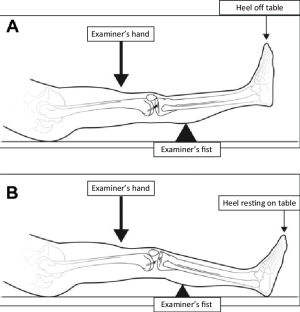Table of Contents
Knee
- weight bearing at the time?
- any sounds? - 'pops' are typical of ACL rupture.
- early knee swelling - indicative of haemarthrosis, intra-articular pathology
- clicking/locking and instability
- suggestive of meniscal tear or chondral pathology
- instability descending stairs suggests PCL damage
- AP axis stability but instability on rotation suggests ACL injury
Examination
Often difficult in acute setting because of pain
Specific exam techniques:
- ACL rupture - Lever test, Lachman and pivot shift tests (View Lachman test)
- PCL rupture - post draw and post sag
- Collateral lig injury - varus and valgus stressing
- Patella injury - patella apprehension test
- Meniscal injury – McMurray test, Apley test
Patella injuries
Patella dislocation
- usually lateral
- reduction
- analgesia - N2O with O2 is effective
- push patella medially while extending knee.
- rigid splint or POP and crutches. Recurrent dislocations may be managed with pressure bandage until review
Patellar fracture
- beware bipartite and multi-partite patella on XRay
- non or minimal displaced with intact extensor mechanism - conservative management
Ligament injuries
ACL rupture
- usually occurs when landing with heel strike through a weight bearing limb
- poor blood supply and resultant little healing, almost always requires reconstructive surgery
- Classically there is a sensation of a ‘pop’ and/or ‘shifting’ with immediate, severe pain which eases rapidly but usually followed by episodes of instability
- rapid onset swelling
- XRay - may see fracture of tibial spine or plateau
PCL rupture
- predominantly extra-capsular, has better blood supply and therefore better healing
- may have instability descending stairs and walking downhill, but surprisingly little other functional loss
- +ve draw test and posterior sag
- conservative management usually with splinting for pain and physio/rehab for recovery
Collateral ligament injuries
- extra-capsular ligs injured in either varus or valgus stress
- Grade I - pain without laxity
- Grade II - pain with some laxity
- Grade III - often pain free with greater laxity
- MCL - conservative Mx usually with hinged knee brace
- LCL - rare and often associated with ACL/PCL rupture
Meniscus injuries
- compression with rotational forces through the knee.
- LCL less commonly because less attached and more mobile
- subacute effusion
- tender joint line.
- McMurray's test when +ve = 95% specific (View test for medial meniscus)
- internal rotation of tibia and Varus stress = lateral meniscus test
- external rotation of tibia and Valgus stress = medial meniscus test
- Apley's test - prone patient with flexed knee. Compression with rotation = likely meniscal injury, Distraction with rotation = likely ligamentous
Tibial plateau fractures
- ACL and MCL injuries associated with lateral plateau fracture
- PCL and LCL associated with medial plateau fracture
Schatzker classification - more serious 1→6. II most common.
| I | Lateral split |
|---|---|
| II | Split with depression |
| III | Pure lateral depression |
| IV | Pure medial depression |
| V | Bicondylar |
| VI | Split extends to metadiaphysis |
Segond fracture
- Classically results from internal rotation and varus stress of the knee in flexion, the Segond fracture is an avulsion injury of the lateral tibial plateau and mid-lateral capsule that frequently accompanies ACL rupture.
- classical appearance - curvilinear or elliptic bone fragment projected parallel to the lateral aspect of the tibial plateau.
- whilst the fracture may seem insignificant there are commonly extensive other injuries
- ACL tear or rupture in >75%
- med or lat meniscal tears ~70%
- avulsion of biceps femoris attachment
Synovial Plica Syndrome
- Synovial Plica Syndrome is a common cause of pain in the antero-medial aspect of the knee
- plicae are folds in the synovium and are found in suprapatellar, mediopatellar, infrapatellar, or lateral locations. The medial plica is the most commonly symptomatic.
- symptoms include: anterior knee pain, clicking, clunking, and a popping sensation on patello-femoral loading activity such as squatting and therefore commonly misdiagnosed as patello-femoral syndrome
- often following strenuous physical work or athletic activity involving repetitive flexion and extension of the knee
- a palpable plica on examination may present as a ribbon like fold of tissue, which can be rolled directly against the underlying medial femoral condyle
- effusion or swelling is usually not present
- more usually a clinical Dx, as a diagnosis of exclusion, Hughston's plica test and Stutter tests are provocative tests commonly used to support the diagnosis if both (best) are positive
- Management - usually/mostly conservative with physiotherapy, quadriceps strengthening exercises
Baker's cyst
- are popliteal synovial cysts, and often associated with other knee pathology including arthritis, meniscal tears, ant cruciate tears, osteoarthritis, inflammatory arthritis etc. Meniscal tears are the most common.
- most commonly found deep to the medial head of gastrocnemius and semimembranosus usually with a valvular opening in post joint capsule
- most common symptoms are swelling behind the knee, or aching, especially worse in extension
- examination may find a lump which is firm with knee extension and soft with flexion
- differential - popliteal artery aneurysm, soft tissue tumours, meniscal cyst, haematoma, thromboemboli, and seroma.
- complications - infection, rupture, and neurovascular compression, thrombophlebitis, compartment syndrome (especially if bleeds following rupture), and compressive neuropathies
- Management
- conservative - treatment of underlying condition, analgesia, ice packs, physio
- steroid injection occasionally
- surgical - generally only if complications







